
Coding Compendium
A free 100-page ebook collecting my projects and tutorials for Raspberry Pi, micro:bit, Scratch and Python. Simply join my newsletter to download it.
Sean McManus was one of 7,500 volunteers who took part in the opening ceremony of the London 2012 Olympic games. Here, he reveals how his part of the show came together, from the first rehearsal to the final flaming ring.
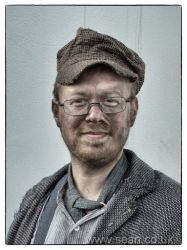 A green and pleasant land: children skipping around maypoles; a cricket match on the village green; and sheep chewing happily on the grass. The villagers start to worry as two stagecoaches roll in, and a man cloaked in black delivers a speech from the hill. "Be not afeard," he says, "the isle is full of noises." And then, the tree behind him is hauled up, and workers crawl out from under its roots, and start pouring down the hill, into the countryside. To the pounding of drums, a thousand others march in, and begin to rip up the grass, clear out the hedges, and build the factories.
A green and pleasant land: children skipping around maypoles; a cricket match on the village green; and sheep chewing happily on the grass. The villagers start to worry as two stagecoaches roll in, and a man cloaked in black delivers a speech from the hill. "Be not afeard," he says, "the isle is full of noises." And then, the tree behind him is hauled up, and workers crawl out from under its roots, and start pouring down the hill, into the countryside. To the pounding of drums, a thousand others march in, and begin to rip up the grass, clear out the hedges, and build the factories.
At the same time, there are flashbacks to our history: Emily Davison steps out in front of the King's horse, and is flipped backwards and lifted up high by her Suffragette sisters; the Jarrow crusaders, protesting against poverty in the north in 1936, march and then stumble in their weakness; and the Empire Windrush arrives, bringing the first post-war immigrants from Jamaica, weighed down by their suitcases.
And in the middle of all this mayhem and industry, with huge beam engines spinning and smoking chimneys rising fast across the land, everyone suddenly stops. They put down their work, look to the poppy field, and stand still for a moment's peace to remember all those who died in war.
The workmen and women put their hats back on, roll up their sleeves and get back to work. Hot iron runs through troughs and is forged to create a giant red hot ring, which rises up high above the workmen. Four other rings fly in to join it, all glowing hot, and as the workers, the drummers, the smelters and the forgers look proudly on, the Olympic rings burst into a shower of flame.
While a billion people saw the rings on their TVs, I was close enough to feel their heat on my face and to smell the smoke. Throughout the summer, I was among 7,500 volunteers who rehearsed in secret to put together a spectacular opening ceremony to welcome the world's finest athletes to London.
My Olympic experience began in November 2011 when I applied to attend an open audition. That first audition was designed to find what we were good at with exercises including dancing, miming a working day, linking hands to form the Olympic rings, and finding our mark on the floor again after being scattered to the walls. "You don't know what we're looking for!" said Steve Boyd, the mass movement director who has worked on every Olympic ceremony since 1992. One of the tasks was to run to a different grid reference depending on whether you'd rather go to Kate Middleton or Katie Price's hen party. I assumed that was just about testing quick reactions, but was there a right answer to that? After all, the royals will probably be at the ceremonies. One thing Steve did admit they were looking for was the kind of people they wanted to spend the summer working with: "Have fun and look out for each other" was the message.
The audition was an uplifting experience, with great music throughout (including one of my favourites, Kiss by Prince). At the end, when we were all hot and sweaty, Steve asked us to stand still, breathe deeply, close our eyes and imagine it was the 27th July 2012. "Can you hear the crowd?" he said. "Can you see the Queen? What colour is she wearing? Whatever happens next, you're part of our story now."
I was excited to get a recall audition. This one focused on acting and we had all earned our place there by miming with gusto at the first audition. We were working with movement director Toby Sedgwick, who coached the zombies in 28 Days Later and choreographed the War Horse stage play, and his team. It was fantastic to see people who had such command over their movements that they could make you feel there was resistance there when they pulled on an imaginary rope, or make you believe in the weight of a pretend pickaxe. As well as various mime exercises, we learned two of the moves that would ultimately end up in the show. This audition was more intense than the first: there was no music and my muscles ached afterwards, but the experience only increased my desire to be part of the show.
In January, I received good news. I had been offered a "character/movement and utility role in a spectacular sequence in the Opening Ceremony" and would be part of Cast Group 44C. More, they weren't telling.
Our first rehearsal took place on a Thursday evening. It had been over four months since we'd received our cast offer, and six months since our auditions, and we still didn't know what we would be doing. "Who's been at work today?" asked Steve, and most people put up their hands. "Who's working with an Oscar winning director?" We were slow to catch on and only a few people raised their hands, but he then introduced opening ceremony artistic director Danny Boyle, who we would be working with over the next three months.
One of the ways that Danny and his team built a strong bond with us and among us was by trusting us with the show's secrets. At the first rehearsal, Danny gathered us around a scale model of the stadium, complete with the green and pleasant land set that would open the show, and talked us through his vision for our sequence. For dramatic effect, he took a scale person out of his pocket and set it down in the seating bowl. The stadium seats as many as Beijing, he said, but is half the size. We would be able to recognise Obama in the audience, he told us. Then he showed us a pre-vis, a mocked-up film of our segment in the show. It was stitched together from rehearsal footage, sketches and library clips, but it was set to the real soundtrack by Underworld, and was absolutely breath-taking.
"They don't think you can do this," said Danny, admitting he'd been warned against attempting the biggest scene change in theatre history. "But I know that you can."
Our first couple of rehearsals focused on choreography and gave us the physical vocabulary we would use later. Working in groups of about 50, we learned arm movements that simulated operating machinery called knobs/dials, shut boot/sliding doors, handle/pull and chisel/hammer. We revised two moves we had learned at the second audition: shovel/pickaxe, which we would perform while surging towards the ring in the final show, and work prep, in which we rolled up our sleeves, mopped our brows and got ready for business.
Then our rehearsals moved to Dagenham, where the stadium had been marked out in 1:1 scale on a car park. This was the first time all 1,000 working men and women (WMW) had come together, and it made an incredible sound when we practised our choreography and all clapped at the same time in our protective leather gloves.
Our first session was about the different props, and we all had a go at handling fences, astroturf, real turf (for the animals), and hedges. The hedges were just empty hedge pots at that time because they were growing elsewhere, and the turf was simulated with deceptively light groundsheets. Some of the fences were extremely heavy, but authenticity was key: real animals, real plants, real wood. The camera would know. As with the choreography training, our props session gave us the basic knowledge and vocabulary we would need so we could handle anything we came across later.
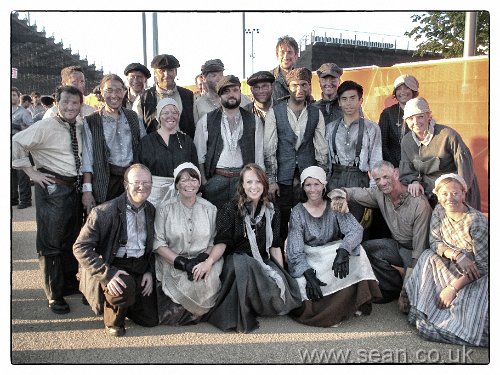
County G (and a few other cast members who joined the photo), posing at Eton Manor before a dress rehearsal.
The field of play was divided into counties, which corresponded with where the fences and hedges carved it up. My county was Gloucestershire (County G), the smallest with a team of just 20 people (others had as many as 190). Being small had its advantages: we could be more flexible in performing our tasks, and we could all get to know each other and become good friends. I had expected volunteers to be largely students or retired people, but most people negotiated flexible working arrangements or took holiday to attend the rehearsals. Our group included a programmer, an MOD employee, a race horse breeder, a union negotiator, a council worker and a nurse.
Our local landmark was the waterwheel and its stream, and our task was to 'strike' (or remove) the astroturf and river banks. Every prop was numbered, and had a red arrow on it for orientation that pointed to the royal box. Each session, we would practise removing our props, interspersed with choreography exercises. We became adept at resetting the stage too, and came to know the reference number, shape and location of our props well.

A map of the stage with the counties marked out.
After a month at Dagenham, we entered the Olympic Park. It was a grey day, but it was impressive to see the bright red Orbit spiralling to the sky, and to get our first glimpses of the Olympic Park. When we got to the stadium's seating bowl, the green and pleasant land was laid out before us, just like the model but life size. It was incomplete but still looked amazing. It seemed smaller than the space we'd been using at Dagenham, an optical illusion caused by having seating all around it instead of a wide open space. But when we started to walk around it, it became clear just how big it was.
Official London 2012 video of the rehearsals for our section. I haven't spotted myself in this, but it reflects my experience well.
We rehearsed two or three days a week on average from June until July, practising our strike pattern, coordinating with other cast groups who were moving around our space, and adding in our choreography. Before a big run-through we'd have a warm-up, with the dance captains leading us from the tor, and the rest of us doing aerobics on the grassy stage.
Each week it got bigger and better. We would find ways to optimise our strike; more of our river bank props would appear, and the stage crew would manage to raise more of the seven chimneys in the time available. Lighting was added in, the drummers rehearsed with us more often, the history parade joined us, and other cast groups were allowed to watch us. A few of us knew people who had seen our show from the seating bowl now, and word went around that it was looking good.
After a few sessions in the stadium, county pride started to kick in. Hampshire wore baggy t-shirts with a giant neon H on them. Lancashire wore red hats with an L plate in the brim. In Gloucestershire, we bought official Team GB wristbands with the Olympic rings and lion mascot on, and picked out the stitching so they just said 'Team G'. Subtle, but classy, we thought.
Every rehearsal something changed, but that's because we were involved in an iterative creative process. Until you've seen 1,000 people doing something, you don't know what it looks like or how long it takes. Toby tried all kinds of creative ways to move us in a huge group, including an amoeba-like formation where the people at the back of the group ran to the front. In the end, there wasn't time or space for any of those movements. At our first rehearsals we were dragging the turf from the ground, but it looked too much like pillaging so we started rolling it up and carrying it instead. That looked more industrious, but took much longer, so the timings changed. Our waterwheel was looked after by specialist stage technicians. The vision was for it to start out small and quadruple in size during the industrial revolution, but it took too long to build and strike, so it became a permanent feature, like the grassy tor at the end of the stadium where the national flags were planted after the athlete's parade.
It wasn't always easy. We were working through the wettest summer on record, and one stadium rehearsal in particular I remember being difficult. The astroturf felt twice as heavy holding so much rainwater, and the stage was slippery. But the mass movement team studied our performance and listened to our feedback. The following week, extra staircases were added to shorten our exit routes and avoid congestion, an extra-grip surface was applied to the ramps, and hedge chutes were invented so the hedges didn't have to be lifted down the stairs. The show continuously evolved, rather than being preordained.
The weather hardened us up too: having worked in wind fierce enough to blow over a fence in Dagenham, and hard driving rain in the stadium, we knew we could handle anything. Steve joked that we could probably do it in high heels backwards.
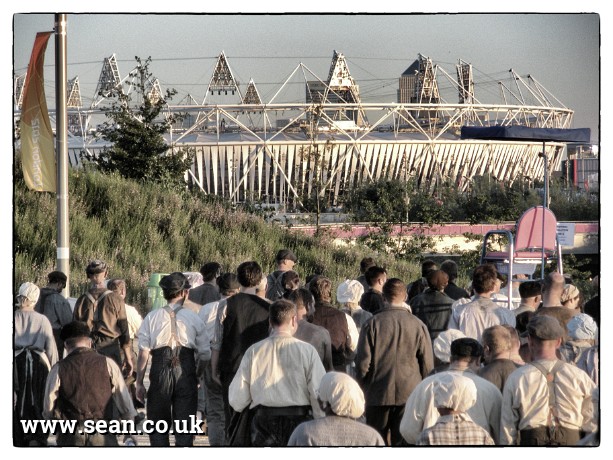
The working men and women walk to the stadium from Eton Manor
In the final two weeks, our rehearsals focused increasingly on the logistics of getting on and off the stage and coordinating with other cast groups before and after our segment. From the dress rehearsals onwards, we were based at Eton Manor, a Paralympics venue on the far side of the Olympic Park. When we first started rehearsing in the stadium the park was heavily locked down, but now most of it was open and the Games Makers had started arriving for training and preliminary work. On our walk to and from Eton Manor, we had a chance to admire the park's landscaping with its wild flowers.
I took this photo of the wild flowers in front of the stadium and Orbit on my way to Eton Manor
We had three dress rehearsals in front of audiences in the final week. We had spent so long rehearsing in the stadium that it felt like my second home, so the rehearsal audiences didn't make me particularly nervous, which surprised me. We were given two tickets for friends and family to attend the second dress rehearsal, so the cast were all particularly excited about that one. Backstage, we were asking each other who we had in the audience that night. I hadn't told my friends or family anything about the content of our show, not because I was worried they'd leak the secrets, but because I wanted them to experience the same thrills and surprises that I had when I saw the pre-vis video without knowing what to expect. I was pleased that my wife Karen and my dad would get a chance to see what I'd been working on for so long first-hand, and to experience the atmosphere and scale of the show in the stadium.
The dress rehearsals went well, and then the final night came. As we walked from Eton Manor, we heard and saw the Red Arrows soar over the stadium, painting the sky red, white and blue, and marking the official start of the show. We walked through the park to the stadium one last time, and Games Makers along the way took photos of us and with us. As we walked the ramp that took us into the lower level of the stadium, a couple of audience members wandering around above us with champagne flutes took our photos and waved to us. We worked our way through the Windrush cast, high-fived the steel band in the corridor as we walked past them, went past the parade leaders in their dresses covered with faces of ceremony auditionees, and made it to our waiting place in a corridor connecting to one of the stadium's entrance tunnels (or 'voms'). We watched the animals go past us down the passage after leaving the stage, and knew that our turn to enter was fast coming.
We all wore in-ear monitors so we could hear the music, the clicktrack and our cues and instructions. Waiting backstage, we listened to the music that would start the show on TV, and counted down from ten with the stadium audience. Steve spoke to us through the monitors: "Guys, think of how long we've come since you auditioned. Things we've been through at Dagenham, in the rain, in the wind. All the long rehearsals here. How much fun is that, right? Friends for life?" I was feeling emotional now, and I could see a couple of my county friends hugging each other. "Good luck everybody," said Toby. "Have a ball!"
When we got our first cue, we walked into the arena, looked to the tor and waited. I could feel my heart pumping. I had a moment to take it in: the flashbulbs popping in the audience, the thunder of the drums. Then came our cue: "Standby strike. Strike go!" And we marched onto the field of play, in time with the music, in front of an audience of 80,000 and a TV audience of a billion.
The final night was like the dress rehearsals, but bigger, brighter and better. The wild flowers we had trampled for a month had been replaced with beautiful new ones, and the steps had been painted green with flowers that day too. Each time I returned to the stage after a strike, the landscape had evolved, the countryside giving way to the industrial revolution. The crowd roared louder and longer than ever before as we slowed down for the peaceful poppy moment. I took my hat off as a mark of respect, and it was good to feel the cool air on my head. I pretended to whistle along, while breathing deeply to prepare for our finale. The stage felt bouncy as I threw myself into our shovel/pickaxe choreography, creeping towards the ring at the centre. We turned and walked towards the audience doing our industrial arm movements as the rings started to assemble above us. Even over the drums, the music, and the clicktrack ticking in my ear, I could hear the crowd cheering. When we looked behind us, the stage was clear of grass and the five rings of the Olympic movement were burning brightly above us. I remembered Danny's words at that first rehearsal: "They don't think you can do this. But I know you can."
Throughout the summer, I had so many moments of joy and discovery as the show's secrets unfolded before me: watching the choreography performed en masse for the first time in the studio; seeing the children bouncing on trampoline beds in Dagenham; watching the dancers rehearsing their hip hop moves; seeing the tree on the tor lift for the first time and people pour out from underneath it; being one of a handful of people in the stadium when the stuntmen rehearsed the Queen's parachute jump; cheering on the fake Team GB in the athlete's parade rehearsal while dancing to Bowie's Heroes with my friends from County G; seeing the dove bikes in the stadium and watching the stadium's lights beat like a dove's wings; hearing the Arctic Monkeys soundchecking; and watching the Abide With Me and NHS sequences in rehearsal, including the Mary Poppins characters flying in over us.
One night, after a long rehearsal, Danny asked for any volunteers to stay and help musical director Rick Smith with a sound recording. I was among the many industrial revolution cast members who stayed behind and cried out and grunted as Rick directed. When you play the soundtrack CD, you can hear us all.
They promised us we would be working with the very best people and we were. Some days were difficult, but nearly every day there was a happy and celebratory atmosphere, with everyone encouraging everyone else. Our team leader Jayde Westaby was fantastic at motivating us and a lot of fun to work with; Danny Boyle spent a lot of time chatting to us, including in the worst rain in Dagenham. Steve, Danny and Toby did an amazing job of organising and inspiring a total cast of over 2,500 for our sequence (including drummers, the parade, and the 'warriors' who did a great job helping us complete our prop strike on time). The wardrobe and make-up people, many of them volunteers, made us look fabulous. And many volunteers looked after us throughout, making sure we had lunch, drinks, sun cream and ponchos when we needed them.
The Olympic Games is humankind's biggest peaceful endeavour, and I am honoured to have played a small part in its history when it visited London in 2012.
As we left the stage at the end of the show, Steve congratulated us and told us we were now part of the cultural history of London. The bell struck by Bradley Wiggins at the start of the ceremony will stand in the Olympic Park for the next 200 years to commemorate the games and their ceremonies, before it must go back to the factory for tuning. "Be not afeard," its inscription says, "the isle is full of noises."
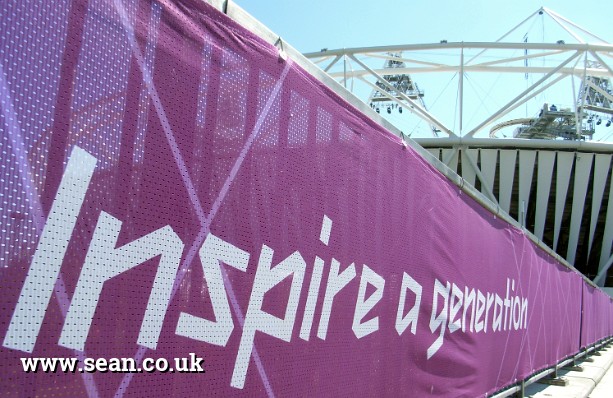
One of the Olympic rings that flew in at the end of our sequence can be seen hidden in plain sight here at the top of the stadium.
With thanks to everyone I worked with this summer, especially my friends in County G and the new friends I made in other counties. If you're thinking about volunteering for the opening ceremony or closing ceremony of a future Olympic Games, definitely give it a go! You'll have a blast.
The Olympic Opening Ceremony was the start of a spectacular summer in London, and I had a chance to see many Olympic and Paralympic events. See more photos from the Olympic Park.
© Sean McManus. All rights reserved.
Visit www.sean.co.uk for free chapters from Sean's coding books (including Mission Python, Scratch Programming in Easy Steps and Coder Academy) and more!

A free 100-page ebook collecting my projects and tutorials for Raspberry Pi, micro:bit, Scratch and Python. Simply join my newsletter to download it.
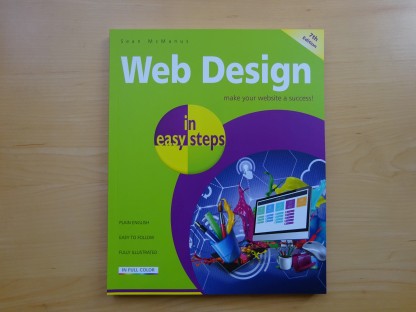
Web Design in Easy Steps, now in its 7th Edition, shows you how to make effective websites that work on any device.

Power up your Microsoft Excel skills with this powerful pocket-sized book of tips that will save you time and help you learn more from your spreadsheets.

This book, now fully updated for Scratch 3, will take you from the basics of the Scratch language into the depths of its more advanced features. A great way to start programming.

Code a space adventure game in this Python programming book published by No Starch Press.

Discover how to make 3D games, create mazes, build a drum machine, make a game with cartoon animals and more!